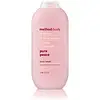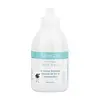What's inside
What's inside
 Benefits
Benefits

No benefits
 Concerns
Concerns

 Ingredients Side-by-side
Ingredients Side-by-side

Water
Skin ConditioningSodium Lauryl Sulfate
CleansingCocamidopropyl Betaine
CleansingParfum
MaskingPolyglyceryl-3 Laurate
EmulsifyingGlycol Distearate
EmollientMethyl Glucose Caprate/Caprylate/Oleate
EmollientPropanediol
SolventAmmonium Chloride
BufferingCoco-Glucoside
CleansingDecyl Glucoside
CleansingC10-18 Triglycerides
EmollientLauryl Lactate
EmollientPaeonia Suffruticosa Flower Extract
Skin ConditioningSodium Chloride
MaskingRosa Centifolia Flower Water
Skin ConditioningGlycerin
HumectantTetrasodium EDTA
Glyceryl Oleate
EmollientGlycol Stearate
EmollientCitric Acid
BufferingEthylhexylglycerin
Skin ConditioningSodium Benzoate
MaskingSodium Hydroxide
BufferingPotassium Sorbate
PreservativePhenoxyethanol
PreservativeMethylchloroisothiazolinone
PreservativeMethylisothiazolinone
PreservativeWater, Sodium Lauryl Sulfate, Cocamidopropyl Betaine, Parfum, Polyglyceryl-3 Laurate, Glycol Distearate, Methyl Glucose Caprate/Caprylate/Oleate, Propanediol, Ammonium Chloride, Coco-Glucoside, Decyl Glucoside, C10-18 Triglycerides, Lauryl Lactate, Paeonia Suffruticosa Flower Extract, Sodium Chloride, Rosa Centifolia Flower Water, Glycerin, Tetrasodium EDTA, Glyceryl Oleate, Glycol Stearate, Citric Acid, Ethylhexylglycerin, Sodium Benzoate, Sodium Hydroxide, Potassium Sorbate, Phenoxyethanol, Methylchloroisothiazolinone, Methylisothiazolinone
 Reviews
Reviews

Ingredients Explained
These ingredients are found in both products.
Ingredients higher up in an ingredient list are typically present in a larger amount.
Cocamidopropyl Betaine is a fatty acid created by mixing similar compounds in coconut oil and dimethylaminopropylamine, a compound with two amino groups.
This ingredient is a surfactant and cleanser. It helps gather the dirt, pollutants, and other impurities in your skin to be washed away. It also helps thicken a product and make the texture more creamy.
Being created from coconut oil means Cocamidopropyl Betaine is hydrating for the skin.
While Cocamidopropyl Betaine was believed to be an allergen, a study from 2012 disproved this. It found two compounds in unpure Cocamidopropyl Betaine to be the irritants: aminoamide and 3-dimethylaminopropylamine. High-grade and pure Cocamidopropyl Betaine did not induce allergic reactions during this study.
Learn more about Cocamidopropyl BetaineCoco-Glucoside is a surfactant, or a cleansing ingredient. It is made from glucose and coconut oil.
Surfactants help gather dirt, oil, and other pollutants from your skin to be rinsed away.
This ingredient is considered gentle and non-comedogenic. However, it may still be irritating for some.
Learn more about Coco-GlucosideDecyl Glucoside is a glucose-based surfactant and emulsion stabilizer. It is created by reacting glucose with the fatty acids from plants.
Surfactants help clean the skin by trapping oil, sebum, and dirt to be washed away. As an emulsion stabilizer, it stabilizes the ingredients in a product by preventing them from separating.
This ingredient is biodegradable and non-toxic. This ingredient is commonly found in baby shampoos.
Decyl Glucoside is sometimes used to stabilize the UV filter Tinosorb.
Learn more about Decyl GlucosideGlyceryl Oleate is the ester of glycerin and oleic acid. This ingredient is mainly an emollient and emulsifier.
Emollients soften and hydrate the skin by creating a thin film on top to trap in moisture. As an emulsifier, glyceryl oleate helps stabilize formulations by preventing ingredients such as oil and water from separating. According to a manufacturer, this ingredient helps helps thicken water-in-oil formulations, shower gels, and hair shampoos.
In some products, this ingredient may be used as a fragrance / perfuming ingredient. The scent of this ingredient is described to be "waxy".
Glyceryl oleate is created from oils rich in oleic acid, such as peanut oil and olive oil.
This ingredient may not be malassezia folliculitis safe.
Learn more about Glyceryl OleateGlycol Distearate serves as a pearlizing or opacifying agent in cosmetic products.
It's often included in cleansers and haircare products to give them a lustrous or shimmering appearance.
It is derived from stearic acid, a natural fatty acid commonly found in vegetable oils and animal fats.
Glycol Distearate isn't fungal acne safe.
Learn more about Glycol DistearateWater. It's the most common cosmetic ingredient of all. You'll usually see it at the top of ingredient lists, meaning that it makes up the largest part of the product.
So why is it so popular? Water most often acts as a solvent - this means that it helps dissolve other ingredients into the formulation.
You'll also recognize water as that liquid we all need to stay alive. If you see this, drink a glass of water. Stay hydrated!
Learn more about Water